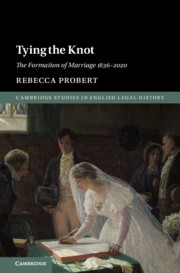Book contents
- Tying the Knot
- Cambridge Studies in English Legal History
- Tying the Knot
- Copyright page
- Dedication
- Contents
- Preface and Acknowledgements
- Abbreviations
- 1 Introduction
- 2 Conception, Design, and Implementation, 1819–1837
- 3 Reactions to the Act, 1837–1854
- 4 Amendments Enacted and Reform Deferred, 1855–1872
- 5 Differences, Divisions, and Dispensing with the Registrar, 1873–1899
- 6 Competing Conceptions of Marriage, 1900–1919
- 7 Consolidating Complexity, 1920–1949
- 8 Convergence? 1950–1993
- 9 The Rise of the Wedding, 1994–2020
- 10 The Legacy of the Past and Lessons for the Future
- Index
7 - Consolidating Complexity, 1920–1949
Published online by Cambridge University Press: 10 September 2021
- Tying the Knot
- Cambridge Studies in English Legal History
- Tying the Knot
- Copyright page
- Dedication
- Contents
- Preface and Acknowledgements
- Abbreviations
- 1 Introduction
- 2 Conception, Design, and Implementation, 1819–1837
- 3 Reactions to the Act, 1837–1854
- 4 Amendments Enacted and Reform Deferred, 1855–1872
- 5 Differences, Divisions, and Dispensing with the Registrar, 1873–1899
- 6 Competing Conceptions of Marriage, 1900–1919
- 7 Consolidating Complexity, 1920–1949
- 8 Convergence? 1950–1993
- 9 The Rise of the Wedding, 1994–2020
- 10 The Legacy of the Past and Lessons for the Future
- Index
Summary
A perusal of the statute book might suggest that there was little change to weddings law during the 1920s and 1930s. There were, however, numerous Church of England Measures that altered the rules governing its weddings and caused them to diverge from those applicable to the newly disestablished Church in Wales. And there were even more orders validating marriages that had not taken place in accordance with the law, illustrating how often mistakes were made. There were also changes in how couples married, with the balance between Anglican and civil weddings shifting in the light of the church’s growing reluctance to conduct the remarriages of the divorced and the changing implications of marrying in a register office. While the Marriage Act 1949 finally brought all of the laws regulating marriage and weddings together into a single statute, it did very little by way of recasting the terms in which the law was stated, even less by way of removing anomalies, and absolutely nothing by way of reconsidering the way in which different types of marriages were regulated in different ways. All it achieved was to consolidate the complexity of the existing law.
Keywords
- Type
- Chapter
- Information
- Tying the KnotThe Formation of Marriage 1836–2020, pp. 170 - 197Publisher: Cambridge University PressPrint publication year: 2021



